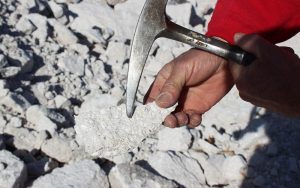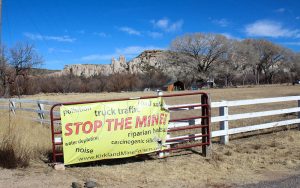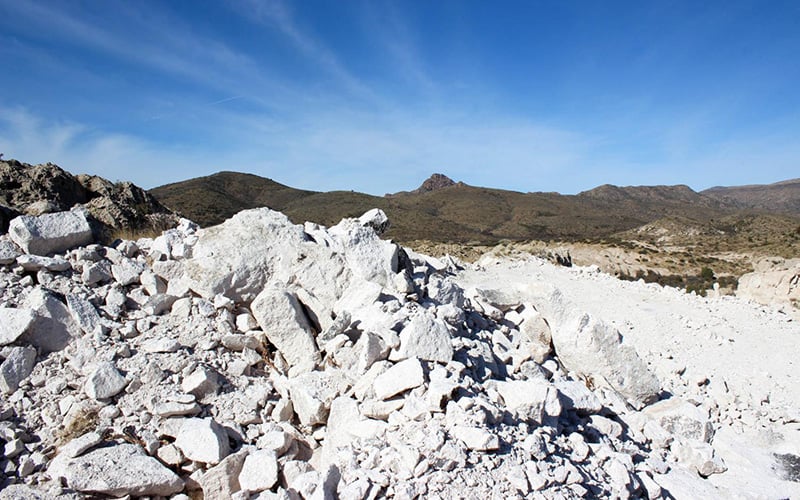PRESCOTT – After more than a year of studies and loud public opposition, the federal government has given the green light to a pozzolan mine on public land in Skull Valley, southwest of Prescott.
Natural pozzolan, which is used to make high quality concrete, is found in deposits of tuff, a glassy, igneous rock formed when deposits of volcanic ash consolidate under pressure over time.
More than 1,000 public comments were filed opposing the mine, ranging from concerns about traffic, noise and dust, the destruction of cultural sites, threats to the yellow-billed cuckoo and the possible presence of an asbestos-like carcinogen known as erionite, which is found near the mine site. Prescott and local volunteer fire departments also are against the operation, which Kirkland Mining Co. hopes to open next month.

Natural pollozan is found in deposits of tuff – hardened volcanic ash – in central Yavapai County. (Photo by Casey Kuhn/KJZZ)
Joe Trudeau, Southwest advocate for the environmental group Center for Biological Diversity, said he’s disturbed that the community’s wishes went unheard.
“Opposition to the mine is a resounding chorus in this region,” he said. “Ninety-nine percent of people around here who have commented are opposed.”
Trudeau, who lives in Prescott, also is concerned about public records that he said show friendly communications between the mining company and the Bureau of Land Management, which oversees the land.
“One of the most surprising things reading through the emails we received in the FOIA (Freedom of Information Act) request was the agreeable nature and tone between the mining company and our public servants,” Trudeau said.
“It almost seems as if the BLM exists to serve the mine and not the public.”
Based on the Mining Act of 1872, owners of mining claims on public land are allowed to use that land for their profit, if the mineral in question is determined to be of high enough quality.
Community fears
Areta Zouvas, president of Kirkland Mining Co., which is based in Scottsdale, denied asking BLM to change its reports.
“We don’t interfere in the BLM reports. Why would we? We’re not hiding anything, and the truth is what it is,” she said.

A sign in Skull Valley outlines reasons the mine is opposed by many locals. (Photo by Casey Kuhn/KJZZ)
But, in one email to the BLM, Zouvas specifically asked BLM employees to stop using the words “asbestos” and “erionite” when referring to Kirkland Mining or its future product. Erionite, which is linked to lung cancer, is a major fear among local residents.
Zouvas said public concerns about erionite were overstated.
“(They said) ‘It’s still a concern, it’s still a concern, what else can we do?'” Zouvas said. “And that’s when I said, ‘Look, at the end of the day, I’ve already tested it, it’s not there.'”
Other emails from 2017 also show Rem Hawes, field manager for the BLM’s Hassayampa office, agreed to leave off that same language from air-quality monitoring reports. Hawes told KJZZ the BLM prepares reports independently, regardless of outside input.
“We studied it. There’s actually been more than one study done on that, and both were negative for airborne carcinogens in general, but including erionite,” Hawes said.
Erionite can be found in Arizona, including in abundance within 10 miles of the mine. The BLM and the mining company have done extensive testing for erionite.
Extensive testing
But Trudeau is concerned about a BLM electron microscope lab test that found less than 2 percent of a mineral with the physical characteristics of erionite in one of the samples.
BLM geologist Shelby Cave says she retested that sample with X-ray diffraction, looking at the chemical composition of the mineral to be even more accurate. She found no evidence of erionite.
“X-ray diffraction is considered the standard method, because this volcanic tuff is extremely fine-grained,” Cave said.
X-ray diffraction may have a limit of detection, however, only able to detect material if more than about 2 percent is present.
Zouvas also said there is no evidence of erionite present.
“It doesn’t exist. It’s been proven a number of times over and over again,” she said. “This is a moot subject at this point for me, and I won’t discuss it.”
In an interview from earlier this year, Al Burch, a geologist contracted by Kirkland Mining, explained why the tuff in Skull Valley is valuable enough to mine.
“It’s very unique because it has just the right chemical composition and just the right physical characteristics to be able to be used as a high-quality natural pozzolan,” Burch said.
Over the public process, the final mining plan changed. There now are protections of several culturally significant archaeological and environmental sites, with at least a 50-foot buffer between them and the mining operations.
“In order for this to move forward,” said Hawes of the BLM, “they had to avoid them or mitigate them, which they did, which protected some areas of a wash nearby as well as some natural and cultural resources in the area. The operator actually changed the plan.”
The appeals period ends in early January, after which Kirkland plans to start digging.
This story is part of Elemental: Covering Sustainability, a multimedia collaboration between Cronkite News, Arizona PBS, KJZZ, KPCC, Rocky Mountain PBS and PBS SoCal.
Connect with us on Facebook.
